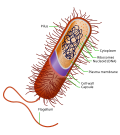Gram-negative bacteria are bacteria that, unlike gram-positive bacteria, do not retain the crystal violet stain used in the Gram staining method of bacterial...
27 KB (2,751 words) - 20:08, 14 April 2025
The Gram stain is used by microbiologists to place bacteria into two main categories, Gram-positive (+) and Gram-negative (−). Gram-positive bacteria have...
24 KB (2,652 words) - 14:02, 13 April 2025
and gram-negative bacteria. It may also be used to diagnose a fungal infection. The name comes from the Danish bacteriologist Hans Christian Gram, who...
28 KB (2,846 words) - 02:06, 9 April 2025
resistant Gram-negative bacteria (MDRGN bacteria) are a type of Gram-negative bacteria with resistance to multiple antibiotics. They can cause bacteria infections...
6 KB (721 words) - 06:18, 8 November 2023
Lipopolysaccharide (redirect from Gram negative shock)
for components of the outermost membrane of the cell envelope of gram-negative bacteria, such as E. coli and Salmonella with a common structural architecture...
63 KB (7,187 words) - 02:15, 4 March 2025
Bacterial cellular morphologies (redirect from Gram-negative anaerobic cocci)
family Moraxellaceae. This genus, Moraxellaceae, comprises gram-negative coccobacilli bacteria: Moraxella lacunata, M. atlantae, M. boevrei, M. bovis, M...
24 KB (2,335 words) - 10:50, 7 April 2025
Darobactin (section Gram-negative bacteria)
experimental antibiotic compound that may be effective against Gram-negative bacteria. If it can be developed into a human-compatible form it would be...
6 KB (494 words) - 00:07, 18 September 2024
of the outer membrane of the cell wall of gram-negative bacteria. Endotoxins are released when the bacteria lyses, which is why after antibiotic treatment...
79 KB (4,099 words) - 18:37, 29 December 2024
Autoinducer (section In gram-negative bacteria)
threshold triggers altered gene expression. Performed by both Gram-negative and Gram-positive bacteria, detection of autoinducers allows them to sense one another...
31 KB (3,939 words) - 15:26, 9 July 2024
Penicillin (category GABAA receptor negative allosteric modulators)
reduced permeability in bacteria, the mechanisms are different between Gram-positive and Gram-negative bacteria. In Gram-positive bacteria, blockage of penicillin...
100 KB (10,771 words) - 06:58, 6 April 2025
peripheral enzyme E1 is an alpha2beta2 heterotetramerin eukaryotes. In Gram-negative bacteria, e.g. Escherichia coli, PDC consists of a central cubic core made...
29 KB (3,340 words) - 02:09, 16 February 2025
bacterial outer membrane called the periplasmic space in Gram-negative (more accurately "diderm") bacteria. Using cryo-electron microscopy it has been found...
20 KB (2,287 words) - 11:18, 19 July 2024
Genetic transformation (redirect from Transformation (bacteria))
80 species of bacteria were known to be capable of transformation, about evenly divided between Gram-positive and Gram-negative bacteria; the number might...
55 KB (6,818 words) - 22:30, 1 April 2025
Bacterial cell structure (redirect from Gram-negative cell wall)
bacterial cell walls, those of Gram-positive bacteria and those of Gram-negative bacteria, which are differentiated by their Gram staining characteristics....
35 KB (4,590 words) - 05:56, 9 November 2024
Quorum sensing (section Gram-negative bacteria)
Both gram-positive and gram-negative bacteria use quorum sensing, but there are some major differences in their mechanisms. For the bacteria to use...
89 KB (10,858 words) - 23:28, 24 February 2025
Atypical bacteria are bacteria that do not get colored by gram-staining but rather remain colorless: they are neither Gram-positive nor Gram-negative. These...
4 KB (427 words) - 20:16, 11 February 2023
Poly(ethylenimine) is also an effective permeabilizer of the outer membrane of Gram-negative bacteria. Both linear and branched polyethylenimine have been used for CO2...
22 KB (2,400 words) - 19:52, 23 September 2024
Cell envelope (category Bacteria)
comprises the inner cell membrane and the cell wall of a bacterium. In Gram-negative bacteria an outer membrane is also included. This envelope is not present...
9 KB (1,169 words) - 03:12, 12 May 2024
Secretion (section In gram-negative bacteria)
cytoplasmic membrane by the twin-arginine translocation pathway (Tat). Gram-negative bacteria have two membranes, thus making secretion topologically more complex...
26 KB (2,981 words) - 20:34, 19 March 2025
Bacterial capsule (redirect from Polysaccharide encapsulated bacteria)
various diseases. The capsule—which can be found in both gram negative and gram-positive bacteria—is different from the second lipid membrane – bacterial...
17 KB (1,785 words) - 22:12, 1 October 2024
Acetic acid bacteria (AAB) are a group of Gram-negative bacteria which oxidize sugars or ethanol and produce acetic acid during fermentation. The acetic...
6 KB (618 words) - 10:32, 25 October 2024
walls of gram-negative bacteria and is recognized by TLR2, which is usually in a heterodimer of with TLR1 or TLR6. Lipoteichoic acid (LTA) from gram-positive...
18 KB (2,144 words) - 17:52, 17 March 2025
that classify bacteria into Gram-positive bacteria and Gram-negative bacteria. The names originate from the reaction of cells to the Gram stain, a long-standing...
152 KB (16,161 words) - 18:50, 6 April 2025
their chemical structure and are effective against both Gram-negative and Gram-positive bacteria. One example is ciprofloxacin, one of the most widely used...
68 KB (6,805 words) - 04:04, 27 March 2025
Septic shock (section Gram-negative)
cases of septic shock are caused by gram-positive bacteria, followed by endotoxin-producing gram-negative bacteria, although fungal infections are an increasingly...
32 KB (3,593 words) - 15:59, 2 April 2025
types: Bacteria can enter the bloodstream in a number of different ways. However, for each major classification of bacteria (gram negative, gram positive...
36 KB (3,771 words) - 19:27, 16 December 2024
ESKAPE (category Antibiotic-resistant bacteria)
to ESKAPEE to include Escherichia coli. This group of Gram-positive and Gram-negative bacteria can evade or 'escape' commonly used antibiotics due to...
21 KB (2,471 words) - 22:41, 19 September 2024
inhibit Gram positive bacteria and some Gram negative bacteria; narrow-spectrum antibiotic can only kill or inhibit limited species of bacteria. Currently...
6 KB (549 words) - 04:08, 4 December 2024
MacConkey agar (section Lac negative)
culture medium for bacteria. It is designed to selectively isolate gram-negative and enteric (normally found in the intestinal tract) bacteria and differentiate...
7 KB (688 words) - 20:17, 18 September 2024
Spheroplast (category Bacteria)
lysozyme. According to some definitions, the term is used to describe Gram-negative bacteria. According to other definitions, the term also encompasses yeasts...
13 KB (1,333 words) - 11:00, 20 January 2025


















